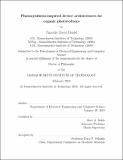Photosynthesis-inspired device architectures for organic photovoltaics
Author(s)
Heidel, Timothy David
DownloadFull printable version (5.696Mb)
Other Contributors
Massachusetts Institute of Technology. Dept. of Electrical Engineering and Computer Science.
Advisor
Marc A. Baldo.
Terms of use
Metadata
Show full item recordAbstract
Organic semiconductor photovoltaics offer a promising route to low-cost, scalable, emissions-free electricity generation. However, achieving higher power conversion efficiencies is critical before these devices can play a larger role in our future energy generation landscape. Organic photovoltaic devices are currently limited by two primary challenges: (1) a trade-off between light absorption and exciton diffusion and (2) low open-circuit voltage due to charge recombination at the donor-acceptor interface. In this work, we demonstrate two new device architectures inspired by photosynthesis that aim to overcome these two challenges. First, we overcome the trade-off between light absorption and exciton diffusion by introducing an external light absorbing antenna layer. We model energy transfer from the antenna to the charge generating layers via surface plasmon polariton modes in the interfacial thin silver contact and via radiation into waveguide modes. We experimentally demonstrate devices with both single layer antennas and strongly absorbing resonant cavity antennas. We measure energy transfer efficiency from the antenna layer to the PV active layers as high as 51±10%. We discuss structural design criteria and describe ideal antenna material characteristics. Second, we reduce charge transfer state recombination in organic photovoltaics by inserting a thin interfacial layer at the donor-acceptor interface. The thin interfacial layer creates a cascade energy structure that destabilizes the Coulombically bound charge transfer state formed immediately following exciton dissociation. We nd the optimal interfacial layer thickness to be approximately 1.5 nm. In CuPc/C₆₀ devices, under simulated solar illumination the short-circuit current increased 34%, the open-circuit voltage increased 33%, and the power conversion eciency increased 49%. Thin interfacial layers can also be used to study the physics of exciton separation.
Description
Thesis (Ph. D.)--Massachusetts Institute of Technology, Dept. of Electrical Engineering and Computer Science, 2010. This electronic version was submitted by the student author. The certified thesis is available in the Institute Archives and Special Collections. Cataloged from student submitted PDF version of thesis. Includes bibliographical references (p. 153-166).
Date issued
2010Department
Massachusetts Institute of Technology. Department of Electrical Engineering and Computer SciencePublisher
Massachusetts Institute of Technology
Keywords
Electrical Engineering and Computer Science.